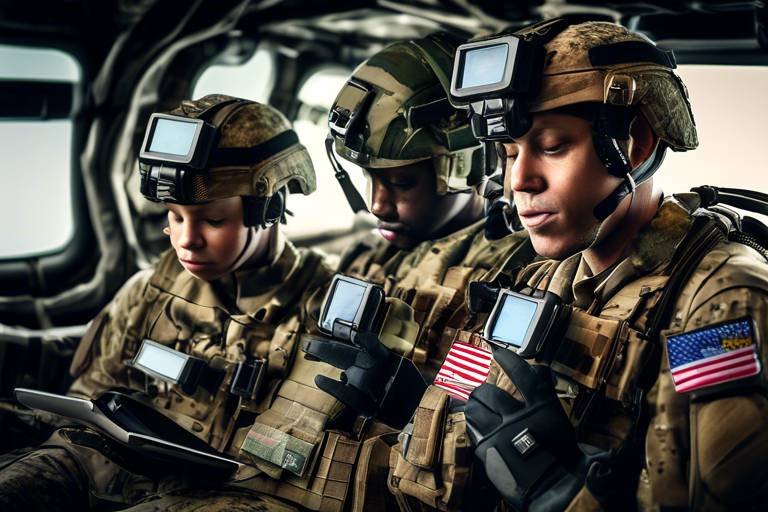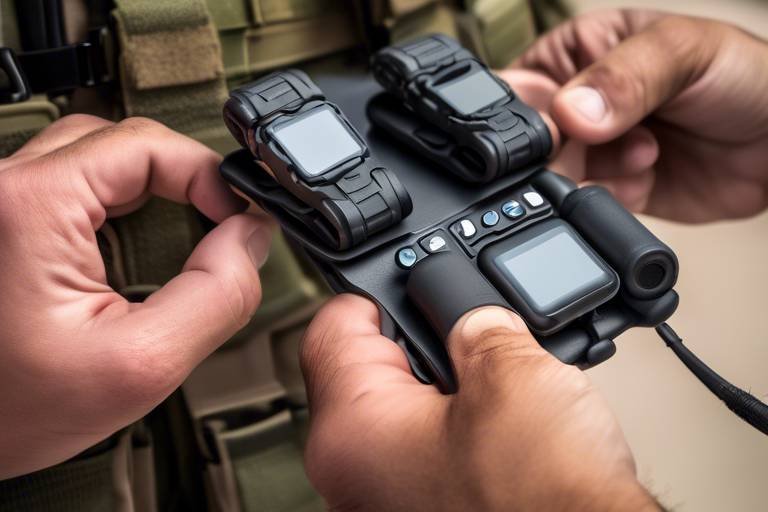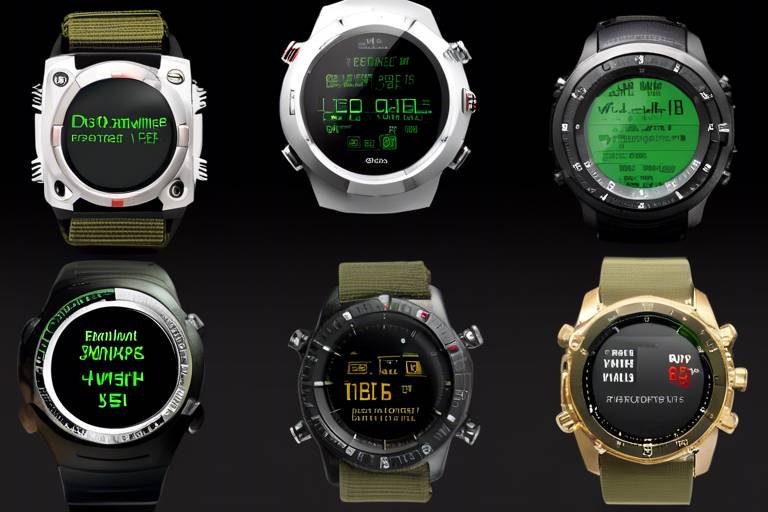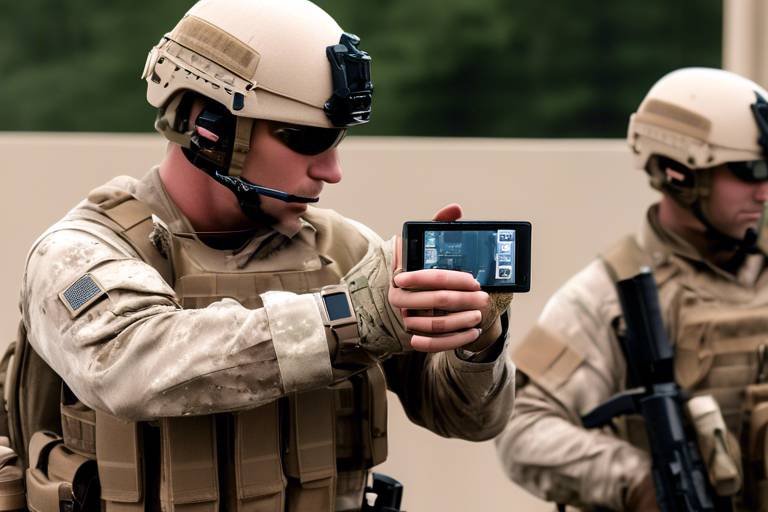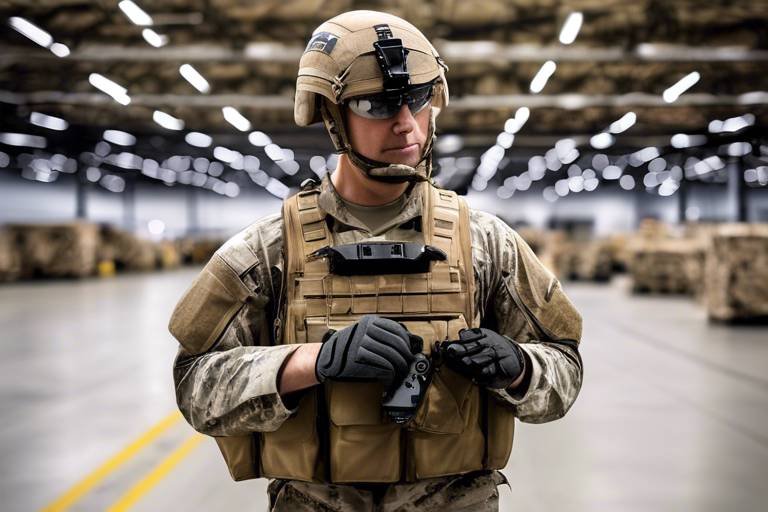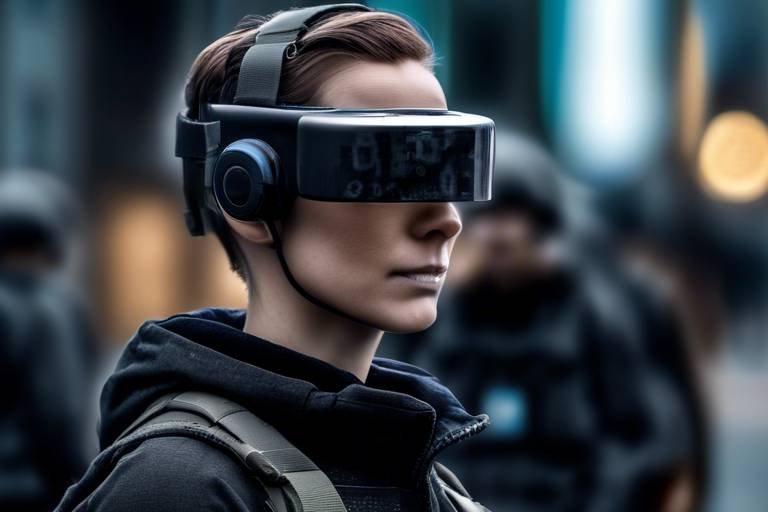How Smart Helmets Can Reduce Combat Injuries
The battlefield is a chaotic and unpredictable place, where every second counts and the difference between life and death can hinge on the smallest detail. In this high-stakes environment, smart helmets are revolutionizing the way soldiers engage with their surroundings. These helmets are not just protective gear; they are sophisticated pieces of technology designed to enhance safety and minimize injuries during combat. Imagine a soldier equipped with a helmet that not only shields them from physical harm but also provides real-time data, advanced communication capabilities, and even augmented reality features. This is the future of military gear, and it is here to change the game.
At the heart of this innovation is the integration of advanced technologies, such as sensors, communication systems, and even drone connectivity. These elements work together to create a comprehensive safety net for soldiers. By offering real-time updates and situational awareness, smart helmets empower troops to make informed decisions quickly. For instance, if a soldier is in a potentially dangerous area, their helmet can alert them to nearby threats, allowing them to take evasive action before it's too late. This proactive approach to safety is what sets smart helmets apart from traditional gear.
Moreover, the benefits of enhanced communication cannot be overstated. In the heat of battle, clear and effective communication can mean the difference between success and failure. Smart helmets facilitate seamless coordination among troops, enabling them to share critical information instantly. This capability not only accelerates decision-making but also significantly reduces the risk of injuries during combat scenarios. When soldiers can communicate effectively, they can work together to avoid potential hazards and respond swiftly to changing situations.
One of the standout features of smart helmets is their ability to share real-time data. This feature allows soldiers to access vital intelligence that can help them navigate dangerous environments. For example, if a soldier is patrolling an area and receives information about enemy movement, they can adjust their strategy on the fly. This kind of agility is crucial in combat, where circumstances can shift rapidly. The integration of smart helmets into military operations ensures that soldiers are always one step ahead of potential threats.
Additionally, the integration of smart helmets with drones provides soldiers with aerial views of the battlefield. Imagine having the ability to see the terrain from above, identifying threats and obstacles before they become immediate dangers. This level of situational awareness is invaluable, as it helps soldiers make informed decisions and enhances their overall safety. By leveraging drone technology, smart helmets create a more comprehensive understanding of the battlefield, reducing the likelihood of injuries.
Another critical aspect of smart helmets is their emergency response features. In the unfortunate event that a soldier is injured, these helmets can alert medics and command centers to the soldier's location and condition. This rapid response capability is essential for expediting medical assistance, which can be a matter of life or death. By ensuring that help arrives quickly, smart helmets play a vital role in improving survival rates on the battlefield.
Furthermore, the incorporation of augmented reality (AR) applications into smart helmets adds another layer of safety. AR can overlay critical battlefield information directly into the soldier's field of vision, helping them navigate complex environments and avoid hazards. Imagine walking through a dense forest with important tactical information displayed right in front of you, guiding your every move. This technology not only enhances situational awareness but also helps soldiers make better decisions under pressure.
As we look to the future, the impact of smart helmets on training and preparedness cannot be overlooked. By incorporating these helmets into military training programs, soldiers can practice in realistic environments while receiving immediate feedback on their performance. This kind of training not only prepares them for real-world scenarios but also builds their confidence in handling stressful situations. Additionally, integrating stress management techniques into smart helmets can help soldiers cope with the pressures of combat, ultimately reducing the likelihood of errors that may lead to injuries.
In conclusion, the evolution of smart helmets represents a significant leap forward in military technology. As we continue to innovate and improve upon these designs, the potential to enhance soldier safety and reduce combat injuries becomes increasingly promising. With features like real-time data sharing, emergency response capabilities, and augmented reality applications, smart helmets are set to redefine the standards of safety in combat.
- What are smart helmets? Smart helmets are advanced protective gear equipped with technology that enhances situational awareness and communication for soldiers in combat.
- How do smart helmets improve soldier safety? They provide real-time data, facilitate communication, and integrate with drones and AR, allowing soldiers to make informed decisions and avoid threats.
- Can smart helmets help in emergency situations? Yes, they can alert medics and command centers to a soldier's location and condition, expediting medical assistance.
- What role does augmented reality play in smart helmets? AR overlays critical information into the soldier's field of vision, aiding navigation and decision-making in complex environments.
Understanding Smart Helmet Technology
Smart helmet technology is revolutionizing the way soldiers engage in combat. Imagine a helmet that not only protects your head but also acts as a high-tech command center, integrating various advanced technologies to enhance a soldier's situational awareness. These helmets are equipped with sensors, communication systems, and even augmented reality capabilities, all working together to provide real-time data that can be crucial in high-stakes environments.
At the core of smart helmet technology is the integration of multiple components that ensure soldiers are always in the loop. These helmets can monitor vital signs, track environmental conditions, and even detect incoming threats. For instance, a soldier wearing a smart helmet can receive alerts about nearby enemy movements or changes in weather conditions, allowing them to make informed decisions quickly. The technology is designed to keep soldiers safe by providing them with the information they need to stay one step ahead of potential dangers.
One of the standout features of smart helmets is their ability to connect with other devices, creating a network of information that enhances teamwork and coordination. This connectivity allows for seamless communication among troops, which is vital for effective operations. Soldiers can share critical information instantly, reducing the time it takes to respond to threats and ultimately decreasing the risk of injuries. With this level of connectivity, the battlefield becomes a more manageable environment, where every soldier is equipped with the knowledge they need to survive.
Moreover, the incorporation of augmented reality (AR) into smart helmets takes situational awareness to a whole new level. Imagine wearing a helmet that overlays tactical information directly onto your field of vision. This technology allows soldiers to see maps, enemy positions, and other vital data without taking their eyes off the battlefield. It's like having a personal assistant right there in the heat of combat, guiding them through complex scenarios and helping them avoid hazards that could lead to injuries.
As we look to the future, the potential for smart helmet technology is immense. The ongoing advancements in sensors, communication systems, and AR capabilities promise to make these helmets even more effective in protecting soldiers. By continuously evolving and integrating new technologies, smart helmets will play a crucial role in reducing combat injuries and enhancing the overall safety of military personnel.
Benefits of Enhanced Communication
Enhanced communication is a game-changer when it comes to the safety and effectiveness of soldiers in combat. Imagine being in a high-stakes situation where every second counts, and the difference between life and death hinges on the ability to share information swiftly and accurately. With smart helmets, this scenario is not just a distant dream; it's becoming a reality. These helmets are equipped with cutting-edge communication systems that allow troops to connect seamlessly, ensuring that everyone is on the same page. This level of coordination can significantly reduce the risk of injuries during combat scenarios, as soldiers can react more swiftly to changing situations and threats.
One of the standout features of smart helmets is their capability for real-time data sharing. This means that when one soldier detects a potential threat or identifies a safe route, that information can be instantly relayed to others in the unit. Think of it as a high-tech game of telephone, but instead of passing along a message that might get distorted, everyone receives the same, accurate information. This immediate access to vital intelligence empowers soldiers to make informed tactical decisions, enhancing their situational awareness and ultimately increasing their chances of survival.
Furthermore, the integration of smart helmets with drone technology takes communication to another level. Soldiers can receive aerial views of the battlefield, which provides crucial insights that ground-level perspectives might miss. For instance, if a soldier is pinned down, the drone can scout the area and relay information about enemy positions or potential escape routes directly to their smart helmet. This capability not only enhances situational awareness but also allows for preemptive actions that can avert dangerous encounters before they escalate into life-threatening situations.
In addition to situational awareness, smart helmets come equipped with emergency response features. In the unfortunate event that a soldier is injured, these helmets can automatically alert medics and command centers to their exact location and condition. This rapid response capability is invaluable; it can mean the difference between life and death. Imagine a soldier who has sustained an injury in a remote area of the battlefield. With the smart helmet's emergency alert system, help can be dispatched within minutes, ensuring that medical assistance reaches them as quickly as possible.
To sum it up, the benefits of enhanced communication through smart helmets are profound. From real-time data sharing to integration with drone technology and emergency response features, these helmets are revolutionizing the way soldiers operate in combat. They not only improve coordination and decision-making but also play a crucial role in injury prevention. As we look to the future, it's clear that the integration of smart helmets into military operations will continue to enhance the safety and effectiveness of our armed forces.
Real-time Data Sharing
In the high-stakes world of combat, every second counts. That's where through smart helmets comes into play. Imagine being in the heat of battle, and suddenly, you receive critical information about enemy positions or incoming threats directly in your line of sight. This isn’t just a fantasy; it’s a reality made possible by the integration of cutting-edge technology into military gear. Smart helmets act as a central hub for data collection and dissemination, ensuring that soldiers are not only aware of their immediate surroundings but also have access to a broader tactical picture.
These helmets are equipped with various sensors and communication systems that gather data from multiple sources, including ground troops, command centers, and even aerial drones. This capability allows for seamless transmission of vital information, which can be life-saving. For instance, if a soldier spots an enemy, they can instantly report the coordinates to their unit, while simultaneously receiving updates about the movements of friendly forces. Such collaborative intelligence can drastically reduce the risk of friendly fire incidents and improve overall mission success rates.
Furthermore, the data shared is not just limited to locations. It can include:
- Health Monitoring: Continuous tracking of vital signs can alert medics if a soldier is injured.
- Environmental Conditions: Information about weather changes or hazardous terrain can be relayed to all units.
- Equipment Status: Updates on weapon readiness or gear functionality can ensure troops are always prepared.
Moreover, the use of augmented reality (AR) in conjunction with real-time data sharing enhances situational awareness significantly. For example, when a soldier looks through their helmet visor, they might see a digital overlay indicating the safest route to maneuver, or highlighting potential threats based on the data received. This integration not only empowers soldiers with knowledge but also boosts their confidence, allowing them to make quicker, more informed decisions on the battlefield.
In summary, real-time data sharing through smart helmets revolutionizes how soldiers operate during combat. By providing immediate access to critical information and enhancing communication, these helmets not only protect lives but also improve mission effectiveness. The future of military operations is indeed looking brighter, thanks to the innovative technology that keeps our heroes informed and safe.
- How do smart helmets enhance soldier safety?
Smart helmets provide real-time data, improve communication, and integrate with other technologies like drones to enhance situational awareness and reduce the risk of injuries.
- What technologies are integrated into smart helmets?
Smart helmets typically include sensors, communication systems, and augmented reality capabilities that allow for comprehensive data sharing and situational awareness.
- Can smart helmets help in emergency situations?
Yes, smart helmets can alert medics and command centers about a soldier's location and condition, expediting medical assistance in case of injury.
Integration with Drones
The integration of smart helmets with drone technology is a game-changer for military operations, offering soldiers a bird's-eye view of the battlefield that was previously unimaginable. Imagine being able to see the entire landscape from above while remaining safely tucked away in a protective gear. This feature not only enhances situational awareness but also provides critical information that can help soldiers make informed decisions in real-time. By leveraging drone footage, soldiers can identify potential threats before they become imminent dangers, allowing for proactive rather than reactive strategies.
But how does this integration work? Smart helmets equipped with advanced communication systems can connect seamlessly with drones, allowing for instantaneous data transfer. This means that as soon as a drone captures footage of enemy movements or hazardous terrain, that information can be relayed directly to the soldier's helmet display. The result? A clearer understanding of the battlefield dynamics, which can significantly reduce the likelihood of injuries. Soldiers can navigate with confidence, knowing they have access to real-time, aerial intelligence.
Furthermore, this integration can be enhanced with features such as:
- Live Video Streaming: Soldiers can receive live feeds from drones, enabling them to view the battlefield as it unfolds and adjust their tactics accordingly.
- Geolocation Data: Drones can provide precise location data, which is crucial for coordinating troop movements and avoiding friendly fire incidents.
- Threat Identification: Advanced algorithms can analyze drone footage to detect potential threats, alerting soldiers before they even spot danger.
In addition to these features, the psychological impact of having drone support cannot be understated. Knowing that they have an aerial ally watching their backs can boost soldiers' morale and confidence, allowing them to focus on their mission rather than worrying about unseen threats. This sense of security can lead to better decision-making under pressure, ultimately contributing to a safer combat environment.
As technology continues to evolve, the potential for drones to work in tandem with smart helmets will only grow. Future advancements may include enhanced AI capabilities that can predict enemy movements or even autonomous drones that can respond to threats without direct human control. This level of integration will undoubtedly revolutionize the way military operations are conducted and further reduce the incidence of injuries on the battlefield.
- What are smart helmets? Smart helmets are advanced protective gear that integrates technology such as sensors and communication systems to enhance soldiers' situational awareness and safety in combat.
- How do drones enhance the capabilities of smart helmets? Drones provide aerial views of the battlefield, allowing soldiers to access real-time intelligence, identify threats, and make informed tactical decisions.
- What future developments can we expect in smart helmet technology? Future iterations may include more sophisticated features such as AI-driven threat detection, improved communication systems, and enhanced integration with other technologies.
Emergency Response Features
In the chaotic environment of combat, the seconds can feel like hours, and every moment counts when it comes to saving lives. This is where the of smart helmets shine the brightest. These helmets are not just protective gear; they are sophisticated devices equipped with technology that can significantly enhance a soldier's safety. Imagine a soldier in the heat of battle, suddenly injured or incapacitated. With smart helmets, help is never far away.
One of the standout features of these helmets is their ability to automatically alert medics and command centers about a soldier's condition and location. This real-time communication can be a game-changer on the battlefield. Instead of relying on a fellow soldier to call for help, the helmet can send out a distress signal immediately upon detecting a severe injury. This rapid response can mean the difference between life and death.
Additionally, smart helmets can be equipped with advanced sensors that monitor vital signs such as heart rate, body temperature, and even blood oxygen levels. If any of these metrics fall outside of safe parameters, the helmet can trigger alerts, ensuring that medical personnel are aware of the situation before they even arrive on the scene. This feature allows for a more proactive approach to soldier care, rather than a reactive one.
Moreover, the integration of GPS technology allows for precise location tracking. In the fog of war, it's easy to lose track of where you are or where your comrades are located. Smart helmets eliminate this uncertainty by providing real-time location data to medics and command units. This means that help can be dispatched quickly and accurately, reducing the time it takes for medical assistance to reach an injured soldier.
To illustrate the impact of these emergency response features, consider the following table that outlines the key functionalities:
| Feature | Description | Benefits |
|---|---|---|
| Automatic Alerts | Helmet sends distress signals upon injury detection. | Faster medical response, potentially saving lives. |
| Vital Sign Monitoring | Tracks heart rate, temperature, and oxygen levels. | Proactive alerts for medical intervention. |
| GPS Location Tracking | Provides real-time location data to medics. | Ensures accurate and timely assistance. |
In conclusion, the emergency response features of smart helmets represent a significant leap forward in military technology. By ensuring that soldiers receive immediate and effective medical assistance, these helmets not only enhance individual safety but also contribute to the overall success of military operations. As we continue to innovate and improve upon these technologies, the potential to save lives on the battlefield grows exponentially.
- What are smart helmets? Smart helmets are advanced protective gear that integrates technology to enhance communication, situational awareness, and emergency response capabilities for soldiers in combat.
- How do emergency response features work? These features allow smart helmets to automatically alert medics and command centers about a soldier's injury and location, enabling faster medical assistance.
- Can smart helmets monitor vital signs? Yes, smart helmets can track vital signs such as heart rate and temperature, providing critical data that can prompt medical intervention.
- What role does GPS play in smart helmets? GPS technology in smart helmets allows for real-time location tracking, ensuring that help can reach injured soldiers quickly and accurately.
Augmented Reality Applications
Augmented Reality (AR) is not just a buzzword; it’s a revolutionary technology that’s making a significant impact on how soldiers operate in the field. Imagine putting on a helmet that doesn’t just protect your head but also enhances your vision with real-time data overlays. This is exactly what smart helmets equipped with AR capabilities offer. They allow soldiers to see critical information right in their line of sight, which can be a game-changer during intense combat situations.
One of the most exciting aspects of AR in smart helmets is its ability to overlay battlefield information. For instance, when a soldier is navigating through a complex urban environment, AR can provide a map of the area, highlight enemy positions, and even mark safe pathways. This kind of immediate access to information can mean the difference between life and death. Soldiers can make informed decisions quickly, reducing the likelihood of injuries caused by ambushes or missteps.
Furthermore, AR applications can facilitate target identification. By using advanced recognition algorithms, smart helmets can help soldiers identify friend from foe, ensuring they engage only legitimate targets. This technology can also provide tactical data on enemy movements, allowing soldiers to strategize their actions effectively. The ability to see enemy positions in real-time can significantly enhance a soldier's situational awareness, leading to better-prepared responses during combat.
In addition to battlefield navigation and target identification, AR can also play a crucial role in training simulations. Imagine soldiers practicing in a virtual environment where they can interact with AR elements that mimic real-world scenarios. This enhances their training by providing a realistic experience without the risks associated with live exercises. They can learn to react to threats, navigate obstacles, and make quick decisions, all while receiving immediate feedback through their smart helmets.
The potential applications of AR in smart helmets are vast and varied. Here are some key areas where AR is making waves:
- Navigation Assistance: Real-time mapping and environmental data help soldiers find their way in unfamiliar territories.
- Threat Detection: Visual cues highlight potential threats, allowing for preemptive actions.
- Team Coordination: AR can show the positions of fellow soldiers, enabling better teamwork during operations.
- Medical Assistance: In case of injury, AR can guide medics to the exact location of a soldier in need of help.
As we look to the future, the integration of AR into smart helmets is expected to become even more sophisticated. With advancements in technology, we can anticipate features such as machine learning that will adapt to individual soldier behaviors, further enhancing their combat effectiveness. The possibilities are endless, and the implications for reducing injuries in combat scenarios are profound.
Q1: How does augmented reality improve soldier safety?
A1: Augmented reality enhances soldier safety by providing real-time information about the battlefield, allowing for better decision-making and situational awareness.
Q2: Can smart helmets with AR capabilities be used in training?
A2: Yes, smart helmets can simulate real-world scenarios, improving soldiers' preparedness and response to threats in a controlled environment.
Q3: What are some potential future developments in smart helmet technology?
A3: Future developments may include advanced machine learning algorithms, better integration with other technologies, and enhanced user interfaces for more intuitive operation.
Impact on Training and Preparedness
In the ever-evolving landscape of military operations, training and preparedness are paramount. The integration of smart helmets into military training programs is revolutionizing the way soldiers prepare for combat. These helmets are not just high-tech gadgets; they are game-changers that enhance a soldier's ability to respond effectively in high-pressure situations. By simulating real-world scenarios, smart helmets provide an immersive training experience that can significantly improve a soldier's readiness.
Imagine stepping into a training environment where every move you make is monitored, analyzed, and instantly fed back to you. This is the reality with smart helmets. They facilitate advanced simulation training, allowing soldiers to practice in realistic environments while receiving immediate feedback on their performance and decision-making skills. This real-time feedback is crucial, as it allows soldiers to identify areas for improvement and adapt their strategies accordingly. The result? A more prepared soldier who can think on their feet when it matters most.
Moreover, smart helmets can be equipped with features designed to help soldiers manage stress. In combat, the pressure can be overwhelming, and maintaining composure is essential. By integrating stress management techniques into the helmet's design, soldiers can learn to cope with high-pressure situations more effectively. For instance, these helmets could provide breathing exercises or calming visuals that help soldiers center themselves before making critical decisions. Think of it as having a personal coach right there in the field, guiding you through the chaos.
The benefits of these helmets extend beyond just individual training. When soldiers train together using smart helmets, they can engage in coordinated exercises that mimic real combat scenarios. This fosters teamwork and communication, which are vital in the heat of battle. Enhanced communication systems allow for seamless coordination among troops, making it easier to execute complex maneuvers. As a result, soldiers become more adept at working as a unit, which can significantly reduce the risk of injuries during actual combat scenarios.
As we look to the future, the potential of smart helmets in training and preparedness seems limitless. With ongoing advancements in technology, future iterations of these helmets are expected to incorporate even more sophisticated features, further enhancing soldier safety and readiness. In this context, the smart helmet is not just a piece of equipment; it is a comprehensive training tool that prepares soldiers for the unpredictable nature of combat.
- What are smart helmets? Smart helmets are advanced headgear that integrate technology such as sensors, communication systems, and augmented reality to enhance soldiers' situational awareness and safety.
- How do smart helmets improve training? They provide real-time feedback during simulations, allowing soldiers to practice in realistic environments and improve their decision-making skills.
- Can smart helmets help manage stress? Yes, they can incorporate stress management features that assist soldiers in coping with high-pressure situations.
- What is the future of smart helmets? Future developments are expected to include even more sophisticated features that enhance safety and preparedness for soldiers in the field.
Simulation Training Enhancements
When it comes to preparing soldiers for the unpredictable nature of combat, simulation training has become a game-changer. Smart helmets are at the forefront of this evolution, offering a range of enhancements that transform traditional training methods into immersive experiences. Imagine stepping into a training environment where every sound, movement, and decision is critical, and you have the power of cutting-edge technology right on your head. That's what smart helmets bring to the table.
These helmets are equipped with advanced sensors and augmented reality (AR) capabilities, creating a realistic training atmosphere that closely mimics real-world scenarios. For instance, soldiers can engage in virtual battles where they must react to threats in real-time, making split-second decisions that could mean the difference between success and failure. This level of engagement not only hones their skills but also builds their confidence, preparing them for the high-stakes situations they will face in the field.
Moreover, the immediate feedback provided by smart helmets is invaluable. After each training session, soldiers can review their performance, analyzing what went well and what could be improved. This feature encourages a culture of continuous learning and adaptation, which is essential in a rapidly changing combat environment. The ability to learn from mistakes in a safe setting can significantly reduce the chances of making the same errors in actual combat.
To illustrate the impact of simulation training enhancements, consider the following table that outlines key benefits:
| Benefit | Description |
|---|---|
| Realistic Scenarios | Soldiers experience lifelike combat situations, improving their tactical decision-making. |
| Immediate Feedback | Instant performance analysis helps soldiers refine their skills and strategies. |
| Enhanced Team Coordination | Simulations promote teamwork and communication, essential for mission success. |
| Stress Management | Training under pressure helps soldiers develop coping strategies for real combat stress. |
Additionally, smart helmets can incorporate stress management techniques during simulations. By utilizing biometric sensors, these helmets can monitor a soldier's heart rate and stress levels, providing real-time insights into their emotional state. If a soldier's stress levels rise beyond a certain threshold, the helmet can offer calming prompts or techniques to help them regain focus. This feature not only enhances their training experience but also prepares them for the mental challenges they will face in combat.
In conclusion, the integration of smart helmets into simulation training is revolutionizing how soldiers prepare for combat. By providing realistic scenarios, immediate feedback, and stress management tools, these helmets are not just accessories; they're essential components in shaping the future of military training. As technology continues to advance, one can only imagine the incredible possibilities that lie ahead for soldier preparedness and safety.
- What are smart helmets? Smart helmets are advanced headgear equipped with sensors, communication systems, and augmented reality capabilities designed to enhance soldier safety and situational awareness.
- How do smart helmets improve training? They provide realistic simulations, immediate feedback, and stress management techniques, allowing soldiers to practice and refine their skills in a safe environment.
- Can smart helmets help in real combat situations? Yes, they enhance communication, situational awareness, and emergency response capabilities, ultimately reducing the risk of injuries during combat.
- What is the future of smart helmets? Future developments may include even more sophisticated features, further improving soldier safety and effectiveness in the field.
Stress Management Techniques
In the high-stakes world of combat, stress can be as dangerous as any weapon. Soldiers often find themselves in life-or-death situations, and the pressure to perform can lead to overwhelming anxiety. This is where smart helmets come into play, integrating cutting-edge technology to help manage stress effectively. Imagine a soldier equipped with a helmet that not only protects their head but also monitors their stress levels in real-time. This is not science fiction; it’s becoming a reality.
Smart helmets can incorporate biometric sensors that track physiological indicators such as heart rate, body temperature, and even sweat levels. By analyzing this data, the helmet can determine when a soldier is experiencing heightened stress and provide immediate feedback. For instance, if a soldier's heart rate spikes due to an imminent threat, the helmet could vibrate gently to alert them to take a moment to breathe and refocus. This simple intervention can make a world of difference in maintaining composure under pressure.
Furthermore, these helmets can offer guided breathing exercises through integrated audio systems. Picture this: a soldier is in the heat of battle, adrenaline pumping, and suddenly they hear a calm voice guiding them through a series of deep breaths. This technique not only helps lower heart rates but also enhances cognitive function, allowing soldiers to think clearly and react appropriately. In essence, it’s like having a personal coach right there with them, ensuring they stay centered.
Additionally, smart helmets can be programmed to include stress management modules that provide soldiers with coping strategies tailored to their individual needs. For example, if a soldier is known to experience anxiety in crowded environments, the helmet could suggest specific techniques to manage that stress, such as visualization or positive affirmations. By personalizing these strategies, smart helmets empower soldiers to take control of their mental well-being in challenging situations.
Moreover, the integration of augmented reality (AR) can further enhance stress management. Imagine a soldier receiving real-time feedback displayed right in their field of vision, reminding them to stay calm and focused. AR can overlay motivational messages or calming visuals that serve to ground the soldier, making them feel less isolated in the chaos of combat. This combination of technology and psychology can create a robust support system for mental health in the field.
In conclusion, the stress management techniques embedded in smart helmets represent a significant leap forward in ensuring soldier safety and effectiveness. By addressing the mental health challenges faced during combat, these helmets not only protect against physical injuries but also fortify the psychological resilience of our troops. As technology continues to evolve, the potential for smart helmets to revolutionize stress management in military operations becomes increasingly tangible.
- How do smart helmets monitor stress levels?
Smart helmets utilize biometric sensors that track physiological indicators like heart rate and body temperature, providing real-time data on a soldier's stress levels. - Can smart helmets help with anxiety management?
Yes, they can offer guided breathing exercises and personalized coping strategies to help soldiers manage anxiety in high-pressure situations. - What role does augmented reality play in stress management?
AR can overlay calming visuals and motivational messages in a soldier's field of vision, helping them stay focused and grounded during combat.
Future Developments in Smart Helmet Design
As we gaze into the crystal ball of technology, the future of smart helmets looks incredibly promising. These innovative devices are set to evolve in ways that will further enhance soldier safety and operational efficiency. Imagine a helmet that not only protects but also empowers soldiers with an arsenal of advanced features designed to keep them safe in the most perilous environments. The integration of artificial intelligence (AI) and machine learning is poised to revolutionize how these helmets function, allowing them to learn from past encounters and adapt to new threats in real-time.
One of the most exciting prospects is the development of next-generation materials. Future smart helmets may utilize lightweight, yet ultra-durable materials that provide enhanced protection without compromising mobility. These materials could absorb impacts better than current options, reducing the risk of concussions and other traumatic brain injuries. Furthermore, advancements in 3D printing technology might allow for customized helmets tailored to the specific needs of individual soldiers, ensuring a perfect fit and optimal performance.
Additionally, the integration of biometric sensors is on the horizon. These sensors could monitor vital signs such as heart rate, body temperature, and stress levels, providing real-time feedback to commanders about a soldier's physical and mental state. This data could be crucial in making split-second decisions during combat, potentially saving lives. Imagine a scenario where a soldier's helmet alerts their unit that they are experiencing extreme fatigue or distress, prompting immediate support or a tactical withdrawal.
Moreover, the incorporation of enhanced augmented reality (AR) features will transform how soldiers interact with their environments. Future smart helmets may project 3D maps of the battlefield directly onto the visor, allowing for seamless navigation and strategic planning. This could be particularly beneficial in urban warfare, where the landscape is constantly changing, and situational awareness is paramount. Soldiers would be able to visualize enemy positions, identify safe routes, and coordinate with their team more effectively.
As we look forward, the collaboration between military forces and tech companies will be vital in driving these innovations. The synergy between defense needs and technological advancements will ensure that smart helmets not only keep pace with the evolving battlefield but also set new standards for safety and efficiency. As these developments unfold, we can expect a future where smart helmets become indispensable tools for soldiers, enhancing their capabilities and significantly reducing combat injuries.
- What are smart helmets? Smart helmets are advanced headgear equipped with technology such as sensors and communication systems to enhance soldier safety and situational awareness in combat.
- How do smart helmets improve soldier safety? They provide real-time data, improved communication, and augmented reality features that help soldiers navigate and respond to threats effectively.
- What future technologies will be integrated into smart helmets? Future helmets may include biometric sensors, next-generation materials, and advanced augmented reality capabilities to further enhance soldier safety.
- How can smart helmets aid in training? Smart helmets can simulate real-world scenarios, allowing soldiers to practice in realistic environments and improve their decision-making skills.
Frequently Asked Questions
- What are smart helmets?
Smart helmets are advanced headgear that integrates cutting-edge technology, such as sensors and communication systems, designed to enhance the safety and situational awareness of soldiers in combat. They provide real-time data and critical information to help protect against potential threats.
- How do smart helmets improve communication among troops?
Smart helmets feature enhanced communication systems that allow for seamless coordination between soldiers. This improved connectivity facilitates quicker decision-making, which can significantly reduce the risk of injuries during combat scenarios.
- What role does real-time data sharing play in combat safety?
Real-time data sharing enables soldiers to access vital intelligence instantly, helping them avoid dangerous situations and make informed tactical decisions. This timely information can be a game changer on the battlefield, potentially saving lives.
- Can smart helmets connect with drone technology?
Absolutely! Smart helmets can be integrated with drone technology, providing soldiers with aerial views of the battlefield. This connection enhances situational awareness and helps identify threats before they escalate, giving troops a significant advantage.
- What emergency response features do smart helmets offer?
Smart helmets can include emergency response features that automatically alert medics and command centers about a soldier's location and condition. This rapid notification system ensures that medical assistance is expedited in case of injury, potentially saving lives.
- How does augmented reality enhance the functionality of smart helmets?
Augmented reality (AR) capabilities in smart helmets overlay critical information onto the soldier's field of view. This helps them navigate complex environments and avoid hazards that could lead to injuries, making AR a powerful tool in combat scenarios.
- What impact do smart helmets have on military training?
Incorporating smart helmets into military training programs enhances soldiers' preparedness by simulating real-world scenarios. This allows them to practice effectively and improve their ability to respond to threats in a controlled environment.
- Can smart helmets help manage stress during combat?
Yes! Smart helmets can integrate stress management features that assist soldiers in coping with high-pressure situations. By reducing stress levels, these helmets help minimize the likelihood of errors that could lead to injuries in combat.
- What future developments can we expect in smart helmet technology?
As technology continues to advance, future iterations of smart helmets are expected to incorporate even more sophisticated features. These developments aim to further improve soldier safety and reduce combat injuries in the field, making them an essential tool for modern warfare.



